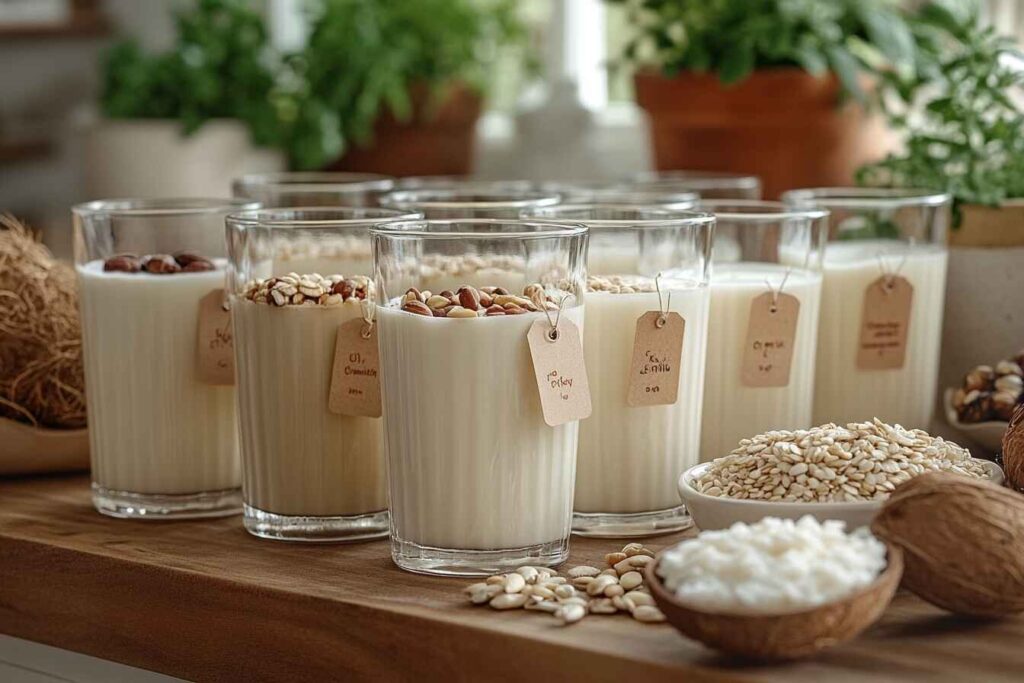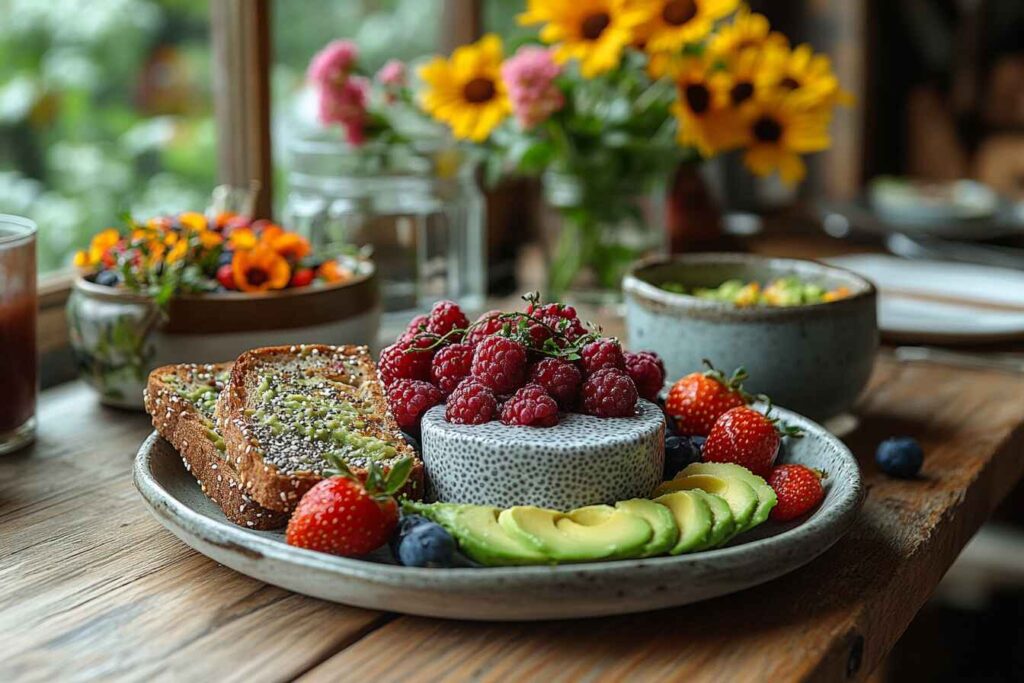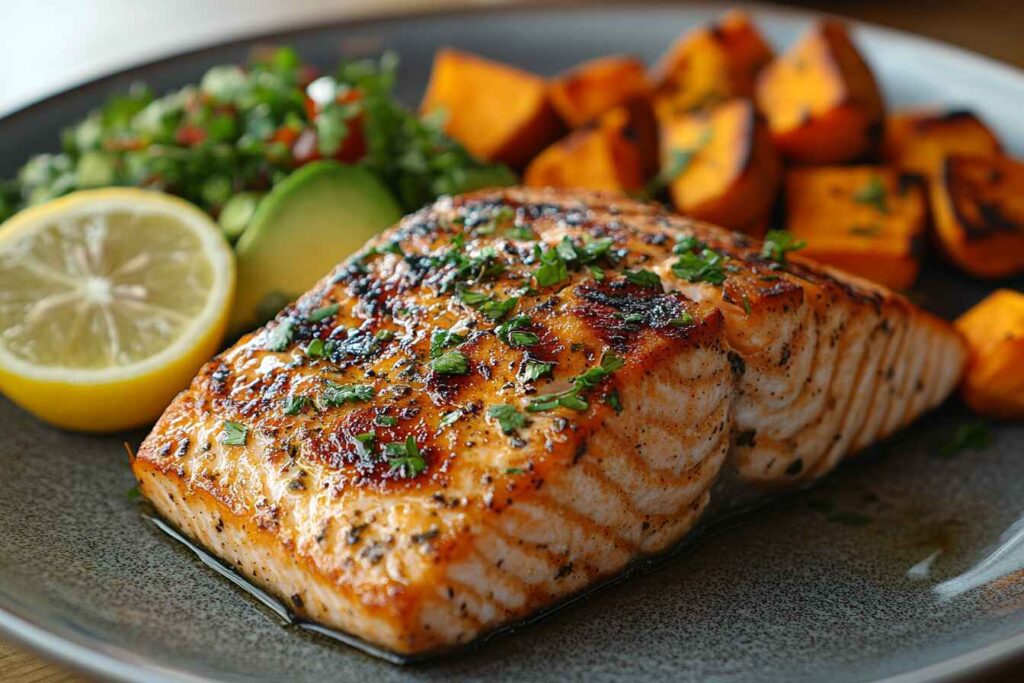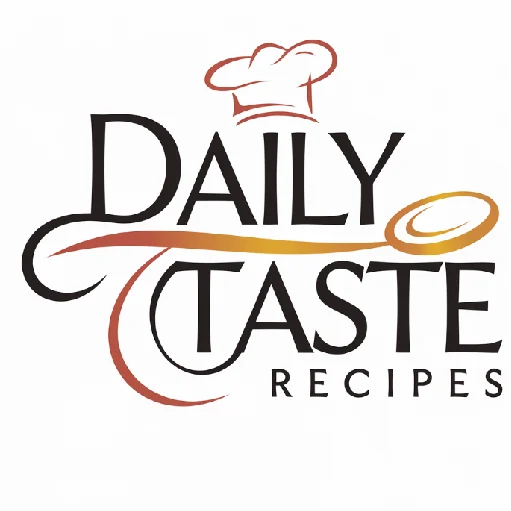Ever wondered what dairy-free and gluten-free people eat? Whether you’re following this diet for health reasons or personal choice, knowing what’s safe and delicious can feel overwhelming at first. But don’t worry! This guide breaks down everything you need to know—from the best foods and substitutes to meal ideas and shopping tips. Let’s explore a world of tasty, allergen-friendly options!
Introduction to Dairy-Free and Gluten-Free Diets
Following a diet free of both dairy and gluten means making some big changes in the way you eat. But that doesn’t mean it has to be boring! If you’re wondering what dairy-free and gluten-free people eat, you’ll be surprised at how many options are available. Many whole foods are naturally safe, and there are plenty of tasty alternatives to traditional dairy and gluten-based products.
Understanding Dairy-Free: What It Means
Dairy-free simply means cutting out all products that come from milk. That includes obvious ones like milk, cheese, yogurt, and butter, but also sneaky sources like whey and casein, which can be found in unexpected foods.
Did you know? Many potato chips and even some deli meats contain hidden dairy!
What Does Gluten-Free Mean?
Gluten is a protein found in wheat, rye, and barley. For those with celiac disease or gluten sensitivity, avoiding gluten is essential. Many foods that seem harmless—like soups, dressings, and even some seasonings—contain hidden gluten. So, if you’re asking yourself, “What do dairy-free and gluten-free people eat?”, the key is to focus on whole, unprocessed foods and reliable substitutes.
Why Do People Follow a Dairy-Free and Gluten-Free Diet?
Some choose this lifestyle out of necessity, while others do it for overall health and wellness. Let’s look at the most common reasons.
Health Conditions Requiring These Diets
- Celiac Disease: A severe autoimmune disorder triggered by gluten.
- Lactose Intolerance: When the body can’t digest lactose, a sugar found in dairy.
- Milk Allergy: An immune reaction to dairy proteins.
- Gluten Sensitivity: Symptoms similar to celiac but without the immune response.
- Skin and Digestive Issues: Some people find that eliminating dairy and gluten helps with acne, bloating, and inflammation.
Common Symptoms of Dairy and Gluten Intolerance
Wondering if dairy or gluten might be causing issues for you? Symptoms can include:
- Bloating and stomach pain
- Diarrhea or constipation
- Skin breakouts or eczema
- Fatigue and brain fog
- Headaches or migraines
Pro tip: If you suspect an intolerance, try an elimination diet—remove dairy and gluten for a few weeks and track your symptoms.
Benefits of Going Dairy-Free and Gluten-Free
Cutting out dairy and gluten can have some surprising benefits, including:
- Better Digestion: No more bloating or stomach cramps.
- Clearer Skin: Some people notice reduced acne and eczema.
- More Energy: Many report feeling less sluggish.
- Reduced Inflammation: Can help with joint pain and autoimmune conditions.
- Weight Management: Avoiding processed foods often leads to healthier eating habits.
Foods You Can Eat on a Dairy-Free and Gluten-Free Diet
If you’re transitioning to this diet, you may be wondering, “What do dairy-free and gluten-free people eat?” The good news is that many foods are naturally free of both dairy and gluten. Here are some of the best options:
Dairy-Free and Gluten-Free Proteins
Protein is essential for muscle growth, energy, and overall health. Here are some safe options:
- Chicken, turkey, and beef (unprocessed)
- Fish and seafood
- Eggs
- Tofu and tempeh
- Beans, lentils, and chickpeas
- Quinoa (a protein-packed grain alternative!)
- Nuts and seeds
Nutrition Facts: 1 cup of cooked quinoa contains about 8g of protein and is completely gluten-free.
Best Dairy-Free and Gluten-Free Grains
Grains can be tricky because many contain gluten, but these are safe options:
- Rice (white, brown, or wild)
- Quinoa
- Buckwheat (despite the name, it’s gluten-free!)
- Millet
- Oats (make sure they’re labeled gluten-free to avoid cross-contamination)
Fruits and Vegetables That Are Naturally Safe
Fresh produce is always a great option! Some of the best include:
- Leafy greens (spinach, kale, lettuce)
- Berries (strawberries, blueberries, raspberries)
- Apples, bananas, and oranges
- Avocados
- Carrots, cucumbers, and bell peppers
- Sweet potatoes (a great gluten-free carb option!)
Healthy Dairy-Free and Gluten-Free Fats
Fats are essential for brain health and keeping you full. Stick to these healthy choices:
- Olive oil and coconut oil
- Avocados
- Nuts and seeds (almonds, walnuts, chia, flaxseeds)
- Nut butters (almond, cashew, peanut butter)
Did you know? Chia seeds are packed with omega-3 fatty acids, making them a great dairy-free alternative to fish oil!
What to Avoid: Hidden Sources of Dairy and Gluten
Some foods may seem safe but contain hidden dairy or gluten. Watch out for:
Sneaky Ingredients That Contain Dairy
- Whey and casein (often found in protein powders)
- Butter and ghee
- Milk powders (in cereals, snacks, and even chips)
- Some chocolate (look for dairy-free options!)
- Dressings and sauces (like ranch and alfredo)
Common Foods That Contain Gluten
- Bread, pasta, and baked goods (unless labeled gluten-free)
- Soups and sauces (often thickened with flour)
- Beer and some alcoholic drinks
- Processed meats (like hot dogs and deli meats)
- Oats (unless labeled gluten-free)
Pro tip: When shopping, look for “certified gluten-free” and “dairy-free” labels to stay safe.
Smart Dairy-Free and Gluten-Free Substitutes
Going dairy-free and gluten-free doesn’t mean giving up on your favorite foods. There are plenty of amazing substitutes that taste just as good—sometimes even better!
Best Dairy-Free Milk Alternatives
Milk is one of the easiest things to replace! Here are some of the best non-dairy milk options:
| Milk Alternative | Best For | Nutrition Facts (Per Cup) |
|---|---|---|
| Almond Milk | Coffee, cereal, smoothies | 30-50 calories, 1g protein, 2.5g fat |
| Coconut Milk | Baking, curries, lattes | 45 calories, 0g protein, 4g fat |
| Oat Milk | Creamy texture, great in coffee | 120 calories, 3g protein, 5g fat |
| Cashew Milk | Rich & creamy, great for sauces | 25 calories, 1g protein, 2g fat |
| Rice Milk | Light and slightly sweet | 120 calories, 1g protein, 2g fat |
Pro tip: Always choose unsweetened versions to avoid added sugars.

Gluten-Free Flour and Baking Substitutes
Baking without wheat flour can be tricky, but these gluten-free options work wonders:
- Almond Flour: Great for cookies, cakes, and muffins.
- Coconut Flour: Absorbs lots of liquid, best in small amounts.
- Oat Flour: Perfect for pancakes and breads (make sure it’s gluten-free).
- Rice Flour: Works well in light baked goods.
- Chickpea Flour: Good for savory dishes and thickening sauces.
Did you know? You can make oat flour at home by blending gluten-free oats until fine!
Cheese, Yogurt, and Butter Alternatives
If you love cheese, don’t worry—there are delicious dairy-free alternatives:
- Dairy-Free Cheese: Brands like Daiya and Violife make great options.
- Coconut Yogurt: Thick and creamy like Greek yogurt.
- Cashew-Based Cheese: Rich and spreadable.
- Vegan Butter: Made from oils like avocado, coconut, or olive.
Meal Ideas and Recipes for a Dairy-Free, Gluten-Free Diet
Wondering what to eat in a day? Here are some delicious meal ideas that are easy to make!
Breakfast Options
Start your day right with these tasty and nutritious breakfast ideas:
- Gluten-Free Oatmeal: Cook with almond milk and top with berries.
- Avocado Toast on Gluten-Free Bread: Add cherry tomatoes and a drizzle of olive oil.
- Chia Seed Pudding: Made with coconut milk and sweetened with honey.
- Scrambled Tofu: A protein-packed alternative to eggs.
Recipe: Chia Seed Pudding
- 1/4 cup chia seeds
- 1 cup almond or coconut milk
- 1 tbsp maple syrup
- 1/2 tsp vanilla extract
- Mix and refrigerate overnight. Top with fruit before serving.

Lunch and Dinner Ideas
These satisfying meals will keep you full and energized:
- Grilled Chicken with Roasted Sweet Potatoes: A simple, balanced meal.
- Zucchini Noodles with Pesto: Swap pasta for zucchini noodles and toss with dairy-free pesto.
- Quinoa and Black Bean Bowl: Add avocado, salsa, and fresh lime juice.
- Baked Salmon with Veggies: A delicious, omega-3-rich dinner.
Snacks and Desserts Without Dairy or Gluten
You don’t have to give up sweet treats! Try these snacks and desserts:
- Hummus with Carrot Sticks
- Almond Butter and Apple Slices
- Gluten-Free Energy Balls (oats, peanut butter, honey, and chia seeds)
- Banana Ice Cream (just frozen bananas blended until creamy!)
Eating Out and Grocery Shopping Tips
Eating dairy-free and gluten-free is easier at home, but what about when dining out or shopping? Here’s how to navigate it like a pro.
How to Read Labels for Hidden Dairy and Gluten
When grocery shopping, always check food labels for hidden ingredients. Look out for:
- For Dairy: Whey, casein, lactose, butter, milk solids.
- For Gluten: Wheat, barley, rye, malt, soy sauce.
Pro tip: Look for “Certified Gluten-Free” or “Dairy-Free” labels to be sure!
Best Restaurants for Dairy-Free and Gluten-Free Meals
Many restaurants now cater to special diets. Here are some safe options:
- Mexican Restaurants: Stick to corn tortillas, grilled meats, guacamole.
- Thai or Vietnamese: Rice-based dishes like curries and pho.
- Salad Bars: Load up on fresh veggies and proteins.
- Sushi: Just avoid soy sauce (or bring your own gluten-free version).
Must-Have Items for a Dairy-Free, Gluten-Free Pantry
Stock your pantry with essentials to make meal prep easy:
- Gluten-free pasta
- Coconut or almond milk
- Quinoa and brown rice
- Gluten-free flour
- Nut butters
- Herbs and spices
Did you know? Most soy sauces contain gluten! Swap it with tamari or coconut aminos.
Common Problems and Solutions When Transitioning to This Diet
Switching to a dairy-free and gluten-free lifestyle isn’t always smooth sailing. Many people face challenges along the way. Let’s talk about common struggles and how to overcome them.
Overcoming Cravings and Finding Suitable Alternatives
One of the biggest hurdles is dealing with cravings. Cheese, bread, and desserts are hard to give up. But the good news? There are amazing substitutes!
- Missing Cheese? Try nutritional yeast! It has a cheesy flavor and is great for pasta and popcorn.
- Craving Bread? Opt for gluten-free brands or bake your own with almond or oat flour.
- Need a Sweet Fix? Dark chocolate (dairy-free), coconut-based ice cream, or homemade energy balls can help.
Pro tip: Keep healthy snacks around so you’re less tempted by gluten or dairy-filled treats.
Dealing with Social Situations and Family Gatherings
Eating out with friends or attending family dinners can be tricky when you’re avoiding dairy and gluten. Here’s how to make it easier:
- Call Ahead: If dining out, check the menu online or call the restaurant to ask about options.
- Bring Your Own Dish: If attending a gathering, prepare a meal you can eat and share with others.
- Communicate Your Needs: Let hosts know in advance about your dietary restrictions.
- Be Flexible: Focus on naturally safe foods like grilled meats, salads, and vegetable dishes.
Budget-Friendly Tips for a Dairy-Free, Gluten-Free Diet
Some people worry that eating dairy-free and gluten-free is expensive. And it can be—if you rely on specialty products. But there are ways to keep costs low:
- Buy Whole Foods: Fruits, vegetables, rice, and beans are naturally dairy-free and gluten-free—and affordable!
- Cook at Home: Pre-made gluten-free and dairy-free foods can be pricey. Cooking from scratch saves money.
- Buy in Bulk: Stock up on gluten-free grains, nuts, and seeds from bulk bins.
- Use Frozen Produce: Frozen fruits and vegetables are just as nutritious but often cheaper than fresh.
Did you know? Making your own almond milk at home costs half as much as store-bought versions!

Conclusion: Embracing a Dairy-Free and Gluten-Free Lifestyle
So, what do dairy-free and gluten-free people eat? Plenty of delicious, healthy, and satisfying foods! The key is to focus on whole, fresh ingredients and experiment with alternatives that work for you.
At first, it may feel challenging, but with a little creativity and planning, you can enjoy a varied and tasty diet. Whether you’re avoiding dairy and gluten for health reasons or simply trying to eat better, the options are endless. So go ahead—explore new recipes, stock up on essentials, and embrace a lifestyle that makes you feel amazing!
Final Tip: Experiment with new recipes, stock your pantry with essentials, and enjoy the journey of discovering amazing dairy-free and gluten-free foods!

